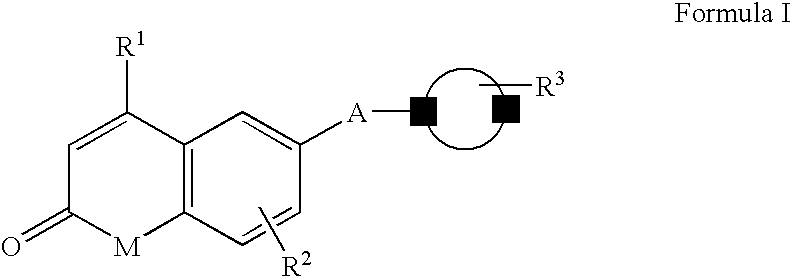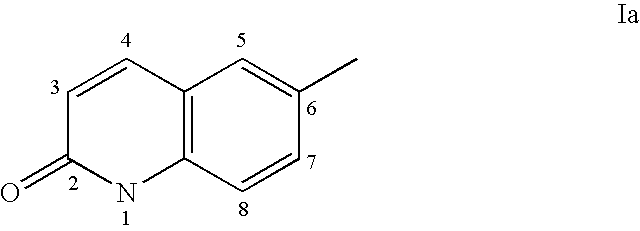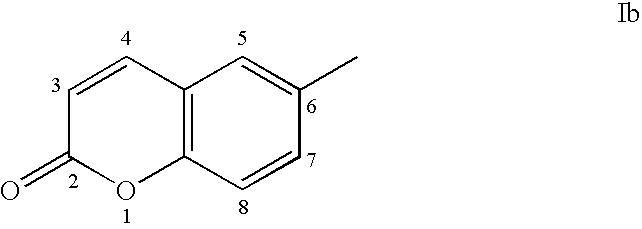Androgen receptor antagonists
a technology of androgen receptor and antagonist, which is applied in the field of androgen receptor antagonists, can solve the problems of limiting the potential applicability of androgen therapy, and the physiological impact of this affinity is often undesirable side effects, and achieves the effect of inhibiting or reducing the activation of androgen receptor
- Summary
- Abstract
- Description
- Claims
- Application Information
AI Technical Summary
Benefits of technology
Problems solved by technology
Method used
Image
Examples
example 1
1-Methyl-6-(piperidine-1-sulfonyl)-4-trifluoromethyl-1H-quinolin-2-one
[0137]
[0138] A solution of 1-methyl-2-oxo-4-trifluoromethyl-1,2-dihydroquinoline-6-sulfonyl chloride (Preparation 1, 65 mg, 200 μmol) in anhydrous DMF (1.5 mL) was treated with NEt3 (31 μL, 220 μmol) and piperidine (21 μL, 210 μmol), before being stirred overnight under N2. The reaction mixture was diluted with EtOAc (70 mL), before being washed with H2O (30 mL), 1 M HCl (30 mL), H2O (30 mL), saturated aqueous NaHCO3 (30 mL), H2O (30 mL), and brine (30 mL). After drying (MgSO4), the organic phase was filtered and concentrated to give a residue that was recrystallised from EtOAc-PE to furnish the title compound (40 mg, 53%): δH (CDCl3)=1.40-1.50 (m, 2H), 1.60-1.70 (m, 4H), 3.05 (t, 4H), 3.80 (s, 3H), 7.20 (s, 1H), 7.55 (d, 1H), 8.00 (dd, 1H), 8.20 (d, 1H); m / z (ES+)=375.1 [M +H]+.
example 2
6-(Piperidine-1-sulfonyl)-4-trifluoromethyl-1H-quinolin-2-one
[0139]
[0140] Condensation of 2-oxo-4-trifluoromethyl-1,2-dihydroquinoline-6-sulfonyl chloride (Preparation 3, 50 mg, 160 μmol) with piperidine (17 μL, 168 μmol), employing NEt3 (23 μL, 168 μmol) as base as outlined for Example 1, gave the title compound (25 mg, 42%): δH ((CD3)2SO)=1.30-1.40 (m, 2H), 1.50-1.60 (m, 4H), 2.90 (t, 4H), 7.15 (s, 1H), 7.60 (d, 1H), 7.90-8.00 (m, 2H); m / z (ES+)=361.0 [M+H]+.
[0141] IC50 181 nm (per procedure of Example 57)
examples 3-11
[0142] These compounds were prepared by solution phase parallel synthesis. The appropriately substituted amine, as described by Formula III in Reaction Scheme 1, (30 μL of a 0.33 M solution in NMP, 9.9 μmol), i-Pr2NEt (20 μL of a 0.50 M solution in NMP, 10.0 μmol), and an appropriately substituted sulfonyl chloride derivative, as described by Formula II of Reaction Scheme 1, (50 μL of a 0.20 M solution in NMP, 10.0 μmol) were mixed together in 1 well of a 96-well plate using an automated liquid handler. After agitating for 66 hours, the solvents were evaporated off under reduced pressure and DMF (50 μL) was added. To ensure dissolution, the mixture was shaken, before being treated with EtOAc (450 μL). Using automated liquid-liquid extraction equipment, the solution was washed with H2O (150 μL) and 1% aqueous NaHCO3 (150 μL). The organic layer was concentrated to furnish the compounds displayed in Table 1.
TABLE 1ExampleCHEMISTRYNameRTBase Peak 31-(1-Methyl-2-oxo-4- trifluoromethyl-...
PUM
| Property | Measurement | Unit |
|---|---|---|
| Pharmaceutically acceptable | aaaaa | aaaaa |
Abstract
Description
Claims
Application Information
 Login to View More
Login to View More - R&D
- Intellectual Property
- Life Sciences
- Materials
- Tech Scout
- Unparalleled Data Quality
- Higher Quality Content
- 60% Fewer Hallucinations
Browse by: Latest US Patents, China's latest patents, Technical Efficacy Thesaurus, Application Domain, Technology Topic, Popular Technical Reports.
© 2025 PatSnap. All rights reserved.Legal|Privacy policy|Modern Slavery Act Transparency Statement|Sitemap|About US| Contact US: help@patsnap.com



